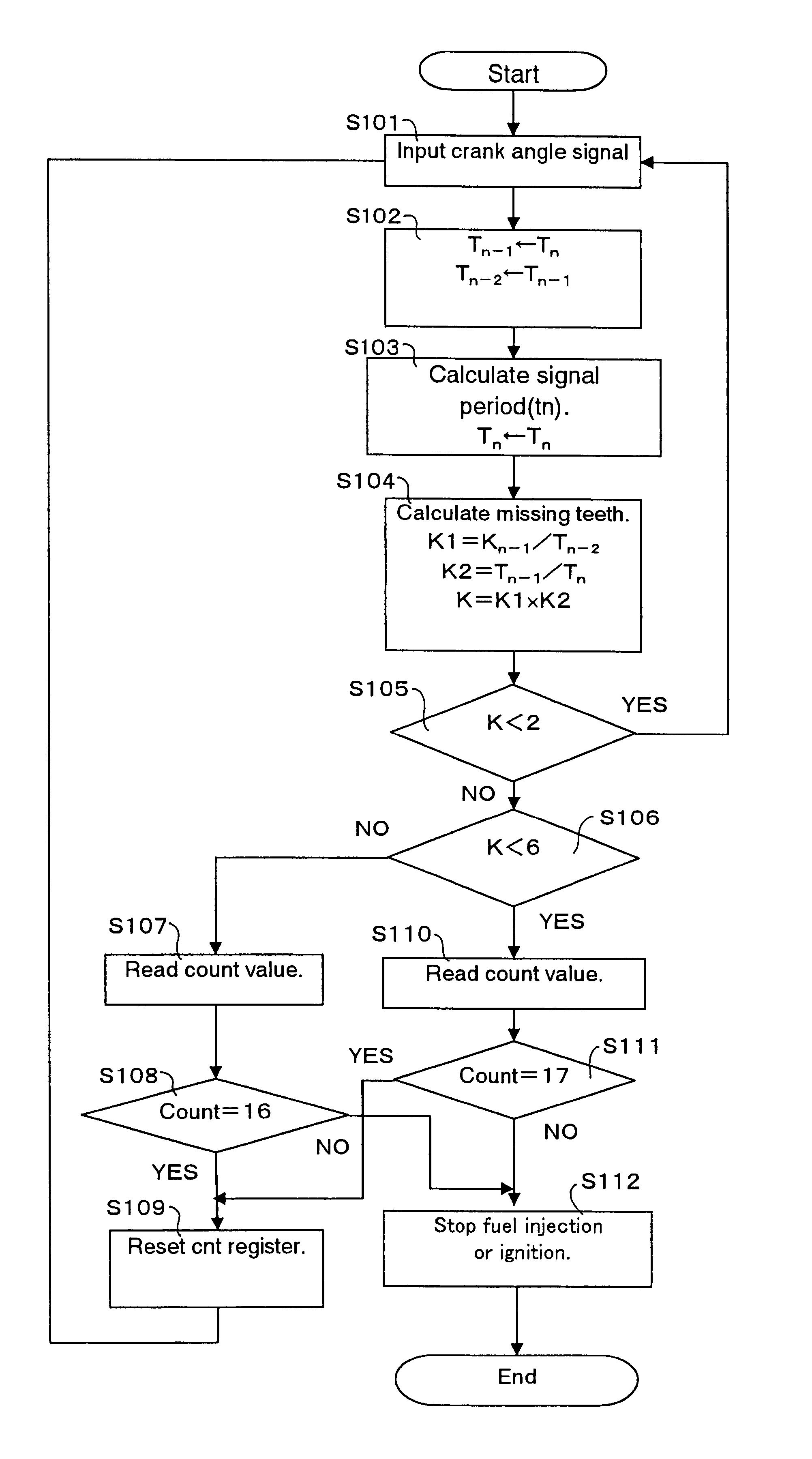Crank angle detection apparatus
a detection apparatus and crank angle technology, applied in the direction of electric control, machines/engines, ignition safety means, etc., can solve the problems of inability to detect the rotational direction or reverse rotation of the engine, and inability to generate the reference crank angle signal for accurately controlling the fuel
- Summary
- Abstract
- Description
- Claims
- Application Information
AI Technical Summary
Problems solved by technology
Method used
Image
Examples
first embodiment
FIG. 1 shows the configuration of a crank angle detection apparatus for an internal combustion engine according to the present invention. FIG. 2 is a pattern chart of a crank angle signal generated by a crank angle sensor when the crankshaft of an internal combustion engine is caused to rotate. FIG. 3 is a flow chart for identifying the rotational direction of the crankshaft according to the crank angle detection apparatus of the first embodiment. FIG. 4 shows periods of the crank angle signal at respective calculation timing. FIG. 5 shows missing tooth determination values K at respective calculation timings. FIG. 6 and FIG. 7 show the count values at respective calculation timings when the crankshaft is rotating in the forward direction and when the crankshaft is rotating in the reverse direction, respectively. FIG. 7 indicates that the crank angle signal numbers are decreasing while the engine is rotating in the reverse direction. For instance, counting of crank angle signal puls...
embodiment 2
FIG. 8 shows the configuration of a crank angle detection apparatus according to a second embodiment of the present invention. This second embodiment is different from the above-mentioned first embodiment in the construction and function of a crank angle sensor, but is similar in other respects to the first embodiment. FIG. 9 shows a crank angle signal generated when the crankshaft of FIG. 8 is rotating in the forward direction, and FIG. 10 shows a crank angle signal generated when the crankshaft of FIG. 8 is rotating in the reverse direction. FIG. 11 is a graph illustrating the periods of the crank angle signals and the missing tooth determination values in the crank angle detection apparatus of the second embodiment. FIG. 12 shows a flow chart for determining the rotational direction of the crankshaft by means of the crank angle detection apparatus of FIG. 8.
A crank angle sensor 13 is provided with an element A 14 and an element B 15 which are arranged adjacent to the measurement ...
embodiment 3
FIG. 13 shows the configuration of a crank angle detection apparatus according to a third embodiment of the present invention. FIG. 14 shows missing tooth determination values of the crank angle detection apparatus of FIG. 13. FIG. 15 shows a flow chart of the operational process of the crank angle detection apparatus according to the third embodiment. In the third embodiment, a same crank angle sensor 13 as that of the above-mentioned second embodiment is used, and a measurement member 18 has a single reference position detection portion 19 alone. In addition, the crank angle detection apparatus includes a period detector or period detection part 6, a reference position determination part 7 and a rotational direction determination part 20.
When the reference position detection portion 19 passes the crank angle sensor 13 during the forward or reverse rotation of the crankshaft 1, the crank angle sensor 13 generates a crank angle signal as shown in FIG. 9 or a crank angle signal as sh...
PUM
 Login to View More
Login to View More Abstract
Description
Claims
Application Information
 Login to View More
Login to View More - R&D
- Intellectual Property
- Life Sciences
- Materials
- Tech Scout
- Unparalleled Data Quality
- Higher Quality Content
- 60% Fewer Hallucinations
Browse by: Latest US Patents, China's latest patents, Technical Efficacy Thesaurus, Application Domain, Technology Topic, Popular Technical Reports.
© 2025 PatSnap. All rights reserved.Legal|Privacy policy|Modern Slavery Act Transparency Statement|Sitemap|About US| Contact US: help@patsnap.com



